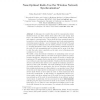Free Online Productivity Tools
i2Speak
i2Symbol
i2OCR
iTex2Img
iWeb2Print
iWeb2Shot
i2Type
iPdf2Split
iPdf2Merge
i2Bopomofo
i2Arabic
i2Style
i2Image
i2PDF
iLatex2Rtf
Sci2ools
109
Voted
ALGOSENSORS
2009
Springer
2009
Springer
Near-Optimal Radio Use for Wireless Network Synchronization
In this paper we consider the model of communication where wireless devices can either switch their radios off to save energy (and hence, can neither send nor receive messages), or switch their radios on and engage in communication. The problem has been extensively studied in practice, in the setting such as deployment and clock synchronization of wireless sensor networks – see, for example, [31,41,33,29,40]. The goal in these papers is different from the classic problem of radio broadcast, i.e. avoiding interference. Here, the goal is instead to minimize the use of the radio for both transmitting and receiving, and for most of the time to shut the radio down completely, as the radio even in listening mode consumes a lot of energy. We distill a clean theoretical formulation of minimizing radio use and present near-optimal solutions. Our base model ignores issues of communication interference, although we also extend the model to handle this requirement. We assume that nodes intend ...
Related Content
| Added | 25 May 2010 |
| Updated | 25 May 2010 |
| Type | Conference |
| Year | 2009 |
| Where | ALGOSENSORS |
| Authors | Milan Bradonjic, Eddie Kohler, Rafail Ostrovsky |
Comments (0)

